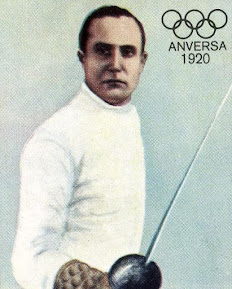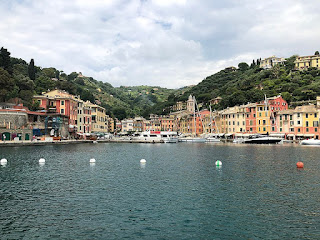Five-medal haul at 1920 Antwerp Games included unique treble
 |
| Nedo Nadi at the age of 18, when he won his first gold |
Born into a fencing family - his father, Giusepppe, was a renowned fencing master - Nadi won five gold medals at the 1920 Olympics in Antwerp, which remained the most by any athlete at a single Games until Mark Spitz won seven swimming titles in 1972.
Nadi’s own distinction is that he was and still is the only fencer to have won a gold medal with all three weapons, winning the individual championship in both foil and sabre and a team gold in the épée.
His quintuple of medals was completed with team golds in both the sabre and foil. His younger brother, Aldo, was also part of the winning Italian team in the épée and sabre events. Their total of seven golds is the most won by members of the same family at a single Games.
Nedo’s historic achievement might never have happened if his father had had his way. Giuseppe believed the épée to be a “crude and undisciplined" weapon and refused to teach it, limiting the two brothers’ tuition to foil and sabre, to which they were introduced as children. Nedo had his first fencing lesson with a foil at the age of seven in his father’s gymnasium at Livorno.
Giuseppe’s objected to épée because he felt it was too easy to score points and required less skill. In foil, a fencer could only score off a hit which landed on the trunk of the opponent’s body; in the sabre, only the upper torso and face mask count as scoring hits. But with épée, a hit landed on any part of the body is legitimate.
 |
| Nadi's Antwerp medal haul, as commemorates in a Panini sticker |
Nedo entered his first Olympics at the age of 18, winning the gold medal in individual foil at the Stockholm Olympics in 1912.
The First World War meant there was no Olympics in 1916. Nedo joined the Italian Army and was decorated for his bravery.
When the Olympics resumed in Antwerp in 1920, Nedo was chosen as flag bearer of the Italian team and captain of the Italian fencing team. He owed his long list of successes in part to the absence of Hungary, who were traditionally strong in the fencing events but who did not take part, along with Russia and other central European countries who had been on the losing side in the war.
Nedo Nadi's talent was to combine perfect balance, timing and rapid reflexes, qualities which served him well in all the disciplines. He would probably have won the individual épée title in Antwerp had a stomach problem not forced him to withdraw.
Antwerp would be his last Olympics. He made the bold decision to turn professional, taking a job as coach at the Buenos Aires Jockey Club, an exclusive sporting institution in Argentina, although in the event he was reinstated as an amateur on his return to Italy.
 |
| Nedo (right) in action against brother Aldo in Cannes in 1935 |
Sadly, Nedo Nadi died prematurely at the age of 45, suffering a stroke from which he never recovered. He was laid to rest in Portofino, the exclusive resort on the Ligurian coast.
Five years before Nedo died, his brother Aldo had moved to the United States, where he taught fencing first in New York and later in Los Angeles, occasionally coaching actors for fencing scenes in films. He even appeared in a film himself, portraying a bodyguard in the 1944 movie To Have and Have Not, starring Humphrey Bogart and Lauren Bacall.
Books:
The History of the Olympic Games: Faster, Higher, Stronger
 |
| Livorno's Venezia Nuova quarter is famed for its network of canals |
The port of Livorno, where Nedo Nadi was born, is the second largest city in Tuscany after Florence yet is often overlooked by visitors, many of whom arrive by cruise ship and travel on to Florence, Siena or other destinations. Yet Livorno has plenty to recommend it as a destination in itself. Built during the Renaissance with Medici money as an “ideal town”, it became an important free port, and until the middle of the 19th century was one of the most multicultural cities in Italy thanks to an influx of residents from all round the world who arrived on foreign trading ships. Visitors to Livorno today can sample some of Italy’s best seafood restaurants, enjoy the elegance of the Terrazza Mascagni on the waterfront and the quirky charms of Venezia Nuova, a former commercial district criss-crossed with canals.
Hotels in Livorno by Booking.com
 |
| The picturesque fishing village of Portofino has been a tourist destination since the late 19th century |
Portofino is an Italian fishing village and holiday resort famous for its picturesque harbour and historical association with celebrity visitors. Situated about 40km (25 miles) east of Genoa on the section of the Liguria coastline known as the Italian Riviera, it is known for the colourful buildings that line the small harbour. The village dates back at least until the early part of the first century, when the Roman author and philosopher Pliny the Elder, who was also a naval commander, made reference to Portus Delphini, the Port of the Dolphi. It began to develop as a tourist destination in the late 19th century, when British and other Northern European aristocratic tourists were enticed by its charms, despite access being mainly by horse and cart nearby from Santa Margherita Ligure. As road links improved, some settled and built expensive holiday houses. By the 1950s, tourism had replaced fishing as the town's chief industry. Restaurants and cafés abound on the waterfront.
Stay in Portofino with Booking.com
Also on this day:
68: The death of Roman emperor Nero
1311: Duccio di Buoninsegna’s alterpiece The Maestà of Duccio is unveiled at the cathedral of Siena
1762: The birth of architect Luigi Cagnola
1898: The birth of racing driver Luigi Fagioli


.jpg)
.jpg)



.jpg)
.jpg)
%20(2).jpg)


